| Columns Retired Columns & Blogs |
@JA (John Alexander)
Why can't bench test results be performed on cartridges? I had Shure and Sheffield Labs test records, that gave a whole gamut of test that can be seen on test gear and graphed out?
Cheers George
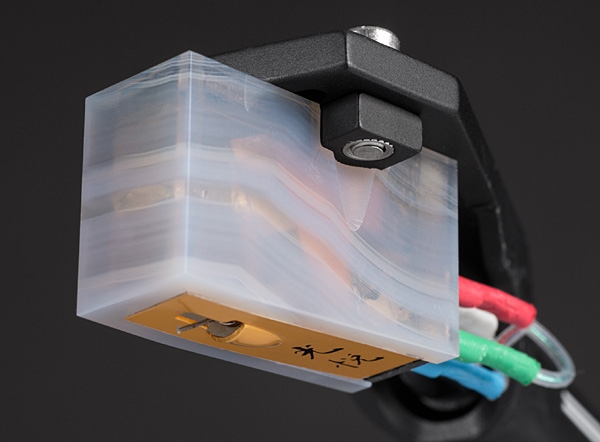
Being responsible for other people's things is nerve-racking enough; when those things are so fragile that the simple act of unpacking them can, if done carelessly or lucklessly, result in a four-figure liability (footnote 1)—this in contrast to step-up transformers, which continue to perform well even when dropped from a great height—I get really nervous. So let's skip the windy intro and get right to it:
Koetsu Onyx Platinum phono cartridge
Earlier this year, while attending the High End show in Munich, I ran into Lionel Goodfield, formerly of Simaudio and now with MoFi Distribution, the US distributor for Koetsu. Goodfield asked if I'd like to write about one of Koetsu's more expensive models— eons ago I reviewed their entry-level Black, which I enjoyed. I happily agreed.
On my way home, I wondered which of Koetsu's 17 models of moving-coil cartridge, ranging in price from $2495 to $14,995, might soon appear on my doorstep. Perhaps it would be one of their five mid-line Urushi models, whose rosewood bodies are clad in gorgeous, multilayer urushi lacquer finishes. Or maybe they'd take their cue from the trademark green of my Shindo Laboratory electronics and loan me a Koetsu Jade Platinum ($9995), its body carved from a solid hunk of jade: a cartridge of even rarer beauty.
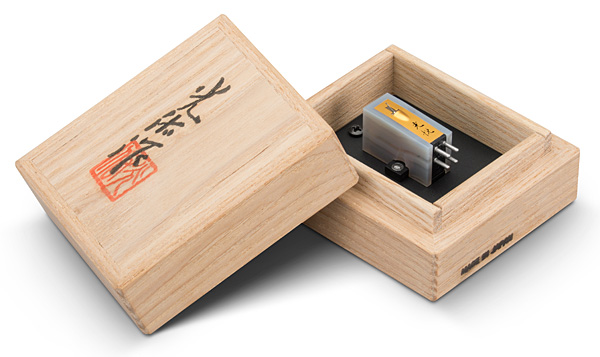
I didn't have to wait long to find out: Soon after my return home, I received a sample of the similarly pretty Koetsu Onyx Platinum, whose body is carved from its nominal gemstone, fitted with an aluminum-alloy mounting plate. The Onyx Platinum has a magnet formed from a platinum alloy, threaded mounting-bolt openings, silver-plated copper coils, a boron cantilever, and a diamond stylus that appears, under mild magnification, to have a Line Contact or similar profile. (Its diamond shank looks slightly longer than average, and is mounted not directly to the boron rod but to a tiny intermediate plate, presumably aluminum.) Specifications include an output of 0.3mV, a recommended load of 80–1000 ohms, and a recommended vertical tracking force (VTF) of 1.8–2.0gm; it weighs 12.5gm and costs $9995.
Yes, the Koetsu line includes two different cartridges that each sell for $9995, and another five—the above-mentioned Urushis—all selling for $5995: shades of Shindo, which not long ago had three different low-power tube amps that all sold for about the same price. Perhaps being an artisan means never having to say you're sorry for knowing that the sound of music is almost infinitely complex, and that various of your creations approach it differently.
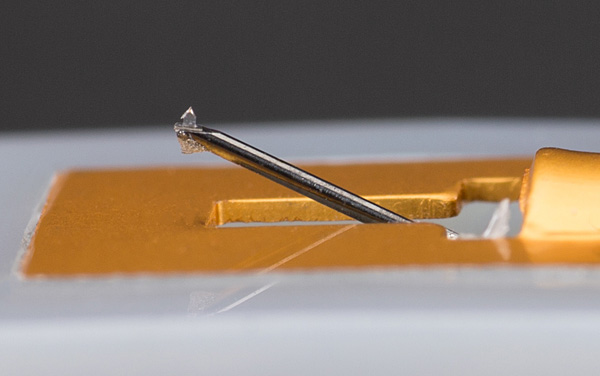
To compare the specifications of Koetsu's 17 different models is to glimpse little in the way of variety: all Koetsu cartridges have the same recommended ranges of VTF and load impedance; all of their platinum-alloy-magnet cartridges have the same 0.3mV output, while all their samarium-cobalt–magnet cartridges output 0.4mV. I asked Lionel Goodfield and MoFi's Jonathan Derda for more information about the differences among various Koetsus—my actual request was for "the deepest insights into how and why [the Onyx Platinum] sounds the way it does"—but neither was able to oblige. As Derda wrote in an e-mail, "Any of our prior efforts to find out the how and why haven't been fruitful." He explained that Fumihiko Sugano, who took over Koetsu after the death of his father, company founder Yoshiaki Sugano, "tends to be a very private person."
But at my behest they persisted, and with the aid of a translator, Derda learned a bit more about the Koetsu Onyx Platinum from the younger Sugano, who described his father's approach to product development as "deductive":
"He was not a scientist nor a scholar. Being a swordsmith/authenticator of samurai swords while working for Toyota, he commercialized the Koetsu items only after he was personally satisfied with their [sound] after a process of trial and error.
"About 40 years ago, he wanted to adopt new housing cases other than wood, and tested a lot of materials, such as elephant ivory, etc. But few met his high standard. Finally onyx came. The combination of onyx and samarium-cobalt magnet played [such] beautiful sounds that it satisfied not only [my father] but also [amplifier designer] Mark Levinson. This is the first stone model, and the second one was jade, and both stone models were introduced into market before Mr. Sugano Sr. retired from the audio business.
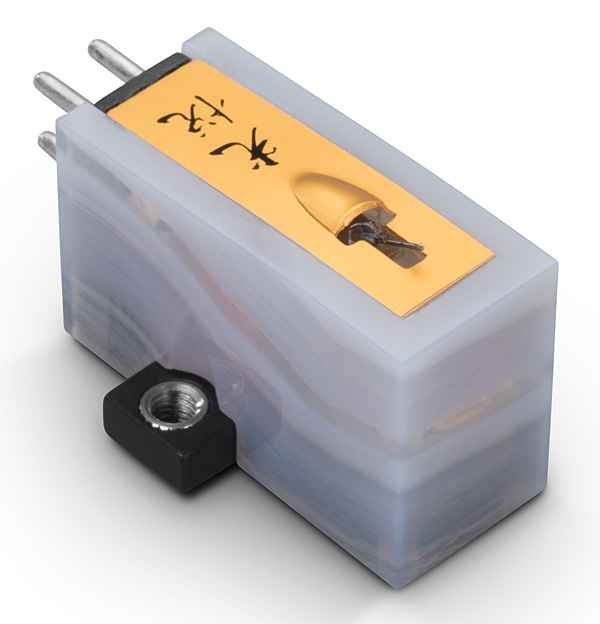
"The platinum magnet came later: About 30 years ago, Mr. Sugano Sr. tried the platinum magnet, and he was fascinated with its sonic range and power. . . . thereafter the platinum magnet was adopted for [Koetsu's] expensive models."
. . . one of which was now on my dining-room table!
I installed the Koetsu Onyx Platinum in an Acoustical Systems Arché headshell, for use with my EMT 997 tonearm and Garrard 301 turntable. Using the Acoustical Systems Smartractor, I adjusted the Onyx's overhang and offset for Löfgren A (DIN) alignment, and set the VTF to 2gm; the cartridge's output was directed to an Auditorium 23 Hommage T1 step-up transformer—as with any such electrically appropriate transformer, this provides the cartridge with an ideal load3—which itself drove the phono stage of my Shindo Monbrison preamp.
Pen and paper were nearby when I first lowered the Koetsu's stylus to a record; I made a grab for them soon after the music began and wrote, "Oh, geez. Oh holy shit. Oh oh oh oh."
The music in question was Herbert Downes's recording of the Orientale from César Cui's Kaleidoscope, from the Electric Recording Company's reissue of Music for Viola and Cello (Parlophone CSD 1499/ERC 028). I had never before heard this recording sound so present and realistic and beautifully colorful. The humanness of the performance was striking: it's difficult to describe, but it seemed I could hear the performers—violist Downes and guitarist John Williams—sneaking up on the melodies' more dramatic moments, alternating between tentativeness and lusty, full-bore mashing of the tone throttle, all the while flying through the piece with a thrilling sense of momentum. That quality was also made evident in Vaughan Williams's Galop, from the same album, as it was in the more broadly paced Ave Maria, by Bach-Gounod —although here, the loudness of a very low C from accompanist Roy Jesson's organ was exaggerated.
The Koetsu was forceful when called for, as I heard in the recording by Ernest Ansermet and the Swiss Romande Orchestra of Ravel's Mother Goose Suite (Decca/Speakers Corner SXL 2062). The pizzicato strings in the Prélude had almost Ortofon SPU–caliber snap, and Ravel's masterful orchestration was honored with fully saturated tonal colors and believable textures. Although it didn't detract from my enjoyment, a few longer-value notes from the double basses had overlong decays, in what seemed a cartridge/tonearm interaction (but see below).
In the title tune of Sonny Clark's Cool Struttin' (Blue Note/Classic 1588), the Koetsu's abundantly rich tone was especially clear in the sound of Art Farmer's trumpet—and yet that sound lacked not an iota of its appropriately realistic bite. The same could be said of Jackie McLean's alto sax, which was rounded but reedy—again, appropriately so. And when McLean played higher in his instrument's register in his first solo in the next number, the Clark original "Blue Minor," it was clear that the Koetsu was giving me not a colored sax sound but a colorful sax sound, albeit near the rich end of the spectrum of believability.
While luxuriating in McLean's sound, I couldn't help noticing the floor-tom roll that drummer Joe Jones executes eight bars into McLean's first solo. It was tactile and believable—perhaps not quite as much so as I hear from a typical SPU, but much better in that regard than I recall hearing from Koetsus of years past. The same could be said of the snare-drum hit that Jones pulls off right before the start of the bowed solo by bassist Paul Chambers, which itself was appropriately large, woody, and altogether lovely.
In the Brahms Piano Concerto 1 with Clifford Curzon, George Szell, and the London Symphony Orchestra (Decca/Speakers Corner SXL 6023), the Koetsu endured in delivering boatloads of color and texture, yet at the same time I've never heard a cartridge with greater, clearer pitch certainty on even the lowest bass notes. This was noticeable in the countermelody played by the double basses in the introductory theme and its reprise just before the soloist's entrance—and in the sounds of the kettledrums, too. With this cartridge, Szell and the London players sounded more electric than ever, and Curzon's forceful touch came across as well as with any cartridge of my experience.
And Ella Fitzgerald singing "Little White Lies," from Ella Swings Lightly (Verve MG VS-6019), was a pure delight. Here the double bass had a fine balance of weight and bounce, the saxes were appropriately reedy and colorful, and Fitzgerald's voice was simply perfect: present, substantial, true of tone, and believably nuanced, with sibilants and plosives that were sufficiently crisp but not overcooked. As a bonus, the Koetsu didn't make too big a deal of the many clicks and pops on my well-worn copy of this great LP.
Using the Hi-Fi News & Record Review Test Record (Hi-Fi News HFN 001), I measured the resonant performance of the combination of Koetsu Onyx Platinum and EMT 997 tonearm. In the lateral plane, the combination exhibited a truly unambiguous peak at 9Hz—the stylus left the groove! Its vertical resonant peak was at 10Hz, and was just as strong, although on that one it didn't mistrack.
All in all, the Koetsu Onyx Platinum communicated color, texture, touch, and musical nuance to an extent and in a combination that I'd never before heard—a very different set of strengths compared to the only other $10,000 cartridge I've reviewed, the Siberian-made Tzar DST. I can't imagine being able to afford either of them, so forgive my glibness in suggesting that anyone who can afford one can surely afford to buy both—and perhaps should.
Ortofon SPU Wood A phono cartridge
During my time at High End 2018, I also visited the sprawling exhibit of Ortofon A/S, which this year celebrates its 100th anniversary. Ortofon's head of product development, Leif Johannsen, took advantage of High End to introduce three limited-edition cartridges—the Concorde Century, SPU Century, and MC Century—and one remarkable new unlimited edition, the SPU Wood A ($1699).
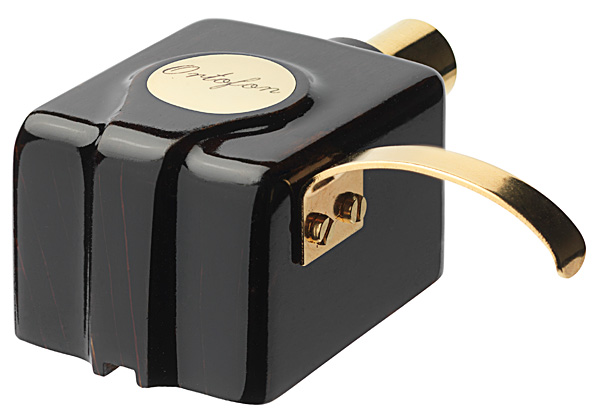
The new model is notable for being the first A-style SPU in nearly a decade. Like the Ortofon mono cartridges that preceded them, the company's first stereo pickup (SPU) products were moving-coil pickup heads—removable headshells with integral cartridges—made with a precise 30mm spacing between stylus tip and tonearm socket. Those A-style pickups were later joined in the Ortofon line by G-style pickups, whose longer bodies—52mm from stylus to tonearm socket—were intended at first to conceal built-in step-up transformers. Though the trannie idea was soon dropped, the G-style bodies endured—and, in fact, prevailed after an early-21st-century accident in which the mold for the A-style bodies was broken.
Footnote 2: A transformer's approximate load impedance can be calculated using the source impedance of the associated cartridge, the load impedance of the associated active phono stage, and the impedance ratio between the transformer's primary and secondary coils. For more on this, see my September 2007 column.

@JA (John Alexander)
Why can't bench test results be performed on cartridges? I had Shure and Sheffield Labs test records, that gave a whole gamut of test that can be seen on test gear and graphed out?
Cheers George

I'd also love to see speaker measurements done upon arrival when new and then after "break in."
Cables would be cool, as well. It would be cool to see the differences.
I love Stereophile's listen, measure, and follow up philosophy.

... following is a link to a HFN review, which includes a set of measurements: https://www.absolutesounds.com/pdf/main/press/HFN_Koetsu%20Onyx%20Platinum_lowres.pdf

Yep ditto, "if" the reviewer gets it right, then it can be seen sometimes in the measurements good and or bad.
A hypothetical to me, if there was only room for one, "subjective reviews" or "test bench measurements", I would opt for the latter.
Cheers George

Was with a Stax CP-X electrostatic cartridge, on a Linn LP12 with Stax UA7 arm.
It took 10-15mins to tune in with it's POD-XE Oscillator/Demodulator and oscilloscope and got about 15-30mins of listening before drifting needing re-tuning.
But what a hyper detailed and dynamic sound, imagine a cantilever with no magnet or coil mass attached to it, and you get the idea of how it traced/tracked the groove, every tiny microscopic bump of recorded info was pickup and presented, without any magnet or coil mass to schlep around to slow things down.
https://www.vinylengine.com/turntable_forum/gallery/image/11682
Why doesn't someone bring back the ESL cartridge with solid state oscillator/demodulator
Cheers George

Forbes: "A 163.41-carat D-color flawless diamond sold for $33.7 million at Christie's Magnificent Jewels sale in Geneva Tuesday. Known as the “Art of de Grisogono, Creation 1,” the rectangular shaped gem is the largest flawless D-color diamond ever to come to auction."
The buyer has said he will be having it made into a flawless cartridge body.
I look forward to the review!
I'm sure that "If you can afford this sort of thing, you won't be disappointed by its sound."

Ortofan wants it measured ........... Just kidding Ortofan :-) ..........

Color D, 163.41-carat, 33.7 million.
What more can I measure?
;-D

Frequency response, output voltage, tracking ability, weight etc.etc, for the cartridge ........ unless, it is an 'ink cartridge' ;-) ..........
There are numerous other types of cartridges :-) ...........

One carat weighs 0.2 grams ........... 5 carats weigh 1 gram :-) .........

May I suggest a better use for that diamond? .......... Why not make a necklace with that diamond and, let a person like the heroine in the movie 'Titanic' (wearing nothing else) wear it, take a picture and/or a painting of that person wearing that necklace, and let us see it :-) ......... It may be a great centerfold spread for Stereophile :-) ............

I love the close up photography of the cartridges in this article. Very nicely done!

How many Plays ?
Can we expect to get 500? more?
Some time ago, I collected Koetsu Phono Cartridges, I owned over 10, I don't recall them to have a Useful Life Span compared to many lesser Phono PUs.
But, they're addictive making their $,$$$ Price justified. ( silly thought )
Who buys these things ? for 10 grand?
I can't imagine the 12,000+ Vinyl Collector owning Pricy Koetsu stuff if they intend on playing all their Albums. ( like Todd the Vinyl Junkie or Chad Kassem might )
That Picture of the Onyx is gorgeous, that's gotta be a Pro Studio Shot, Civilians can't do that kind of image. Can they?
Tony in Michigan
ps. My Koetsu warrantee experience is that there isn't one to speak of.
ps.2 Koetsu : Still have those shitty little boxes. Phew!!!

I have photographed my cartridge with a 1:1 macro lens and could not get that close. Canon makes a 5:1 macro lens. I suspect this is what the photographer used to get that close and show the stylus that big.
A shot like this has to be taken on a sturdy tripod. The smallest vibration is amplified in the image. The lighting needs to be perfect as well. Nice work!

If somebody could come up with a DAC with a frequency response like the Koetsu Onyx Platinum and with a heavy dose of 2nd harmonic distortion, they could make lots and lots of money ........ Of course, they are not gonna send a review sample to Stereophile because in addition to listening, Stereophile also does measurements :-) ..........

a Koetsu DAC?
Kinda a tuby R2R device made to make RedBook sound like a vinyl 33.3.
Just a tiny bit of reverse engineering to get 21st Century back to 1975ish. Hmm
Tony in Michigan
ps. maybe the clever lads could clone the Shindo "sound" signature profiles & dam the measurements ..... ( sorry Mr.JA )

Tuby? ........ Tubes are like politicians ........ They always tell the truth :-) ........
...... and you guessed it, they both tell 'sweet little lies' :-) ............

We see them everyday on TV news ......... I know few politicians :-) .......... Yes, I also know few tubes :-) .......

...in fact I think Border Patrol, Lector, Cary, Aesthetix and Audio Note make some. Asking for enjoyable music to be played without a little euphonic coloration or enhancement is like asking for enjoyable writing to be dry and clinical, unimaginative and without a creative use of language. If you want that, read the instructions to a prescription drug. If I wanted razor flat measurements and 100% dedication to the source - which 99% of the times was recorded with euphonic colorations oh and by the way the acoustics of Carnegie Hall would be considered coloration to these numbskulls - I would work and live in a laboratory. Luckily I don't and will continue to enjoy music that is artificially enhanced and colored. Like the sound of a sustained tone on a Stradivarius and I can go on and on.

..it would probably be a case of painted ugliness vs natural beauty.

Hmm, a ROLEX Watch takes a year to make. They have tiny components, they seem to last a Life-time and come with a Factory Warrantee, are 100% Hand Made by Skilled Craftsmen and Craftswomen. Fit and Finnish is impeccable !!! Service on everything they ever made is available, including Full restorations. ( for a price, of course )
Yet they cost under $10,000
The $10k Koetsu Onyx has a Gold painted plate that doesn't properly fit the Body.
Isn't it rare for something with "ROLEX" quality to be less pricy ( cheaper ) than something so obviously inferior?
Seems like "The Vinyl" Manufacturers are "Playing-us" for suckers.
Are Audiophiles Suckers?
Tony in Michigan

... of the Ortofon Cadenza Red, would anyone but a "sucker" spend about eight times its price for a different cartridge - especially one whose frequency response starts rolling off at about 2 or 3 kHz, instead of being flat out to about 15kHz?
https://www.ortofon.com/media/147328/Cadenza%20Red%20HiFi%20News%2007-2012_Eng.pdf

Koetsu got 89% for sound quality and Ortofon got 80% for sound quality :-) .........
Whole 9 yards :-) ..........
Wonder whether the $15,000 Koetsu phono-cartridge will get 99.999999% for sound quality? :-) ......
...
That would be equivalent to a 'touchdown' or a 'home-run' :-) ...........

Hmm, a ROLEX Watch takes a year to make . . . Service on everything they ever made is available, including Full restorations.
Not any more, I am afraid. When my wife and I got engaged in 1987, we bought each other second-hand Rolex "bubbleback" watches. (Mine is a 1939, hers a 1940.) We had the watches serviced by Rolex up to a few years back, when the Rolex service center in Manhattan told us that the company would no longer support "legacy" models. :-(
John Atkinson
Editor, Stereophile

Apple Watch is a better investment ........... Apple Watch has taken over as number one best selling watch in the world :-) ...........

a TimePiece and much more.
A ROLEX is a Statement made out of Jewelry.
The person wearing the ROLEX has people to do the technical stuff, who then report back on progress.
The Apple is a better watch but not as good a watch as a Indiglo Quartz Timex Easy-reader watch ( for $29 ).
The Apple is a Computer ( 17% of Global Smart watch market )
The ROLEX is Status
The TIMEX is Time
Tony in Michigan

"The person wearing the ROLEX has people to do the technical stuff, who then report back on progress" ........
Wonder whether JA fits that description of person wearing ROLEX? :-) ..........

... he certainly has people reporting to him.
I wonder if JA now wears one of the new Yachtmasters or GMT?
ROLEX have a Rail Watch that our JA might wear whilst commuting on the NY Subway system. Hmm.
I suspect that our JA now wears one of the newer Apple devices ( the one with the heart monitor ) :-)
Tony in Michigan

JA is wearing the Apple Watch which plays ...........
"So Alive" ........... Goo Goo Dolls ........ on Bluetooth headphones :-) .........
JA is also asking Siri for directions to the Taylor Swift concert on his Apple Watch :-) ........

... Rolex watches." quoted J. Atkinson.
In same 1987, I bought my wife a new Rolex Oystersteel/yellow gold watch to make up the cheap tiny diamond engagement ring that I could only afford to give her 20 years back then.
So Rolex is for status.
Koetsu cartridges are for status or for sound or for both ????
Unlike my broke old times, I can afford any cost-is-nothing audios today.
My question: do I NEED to drop a bundle for a costly MC cartridge, like Koetsu when I am so happy with mine of low-status ? Does it really make such temptingly superior sonic difference ?
Jack L.
Canada

...in the world." quoted Bogolu Haranath.
Hi
Yes, Apple Watch outsells its watch competition in quantity.
Yet, I recently read in the newspaper about its durability: its glass face tends to break even with normal wearing.
Apple standard warranty does NOT cover smashed glass watch face for whatever reason.
So wear with caution!
Jack L.
Canada